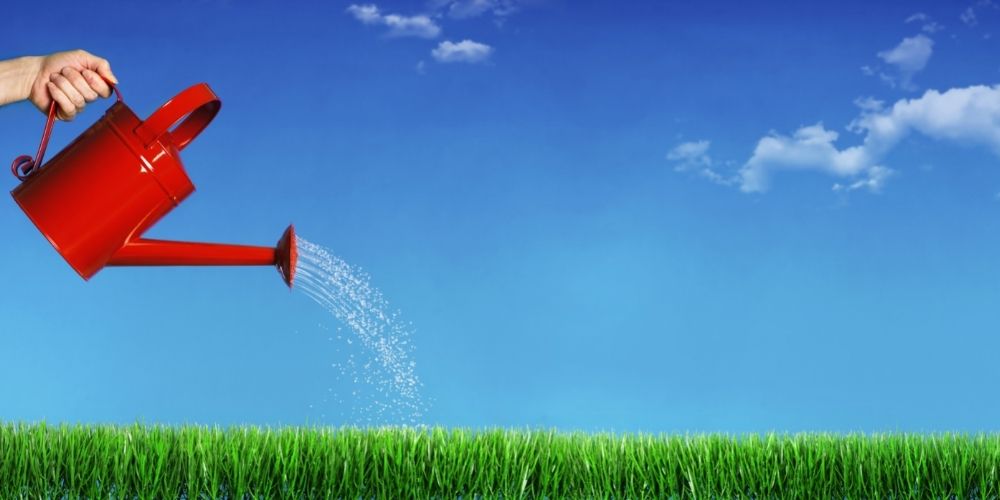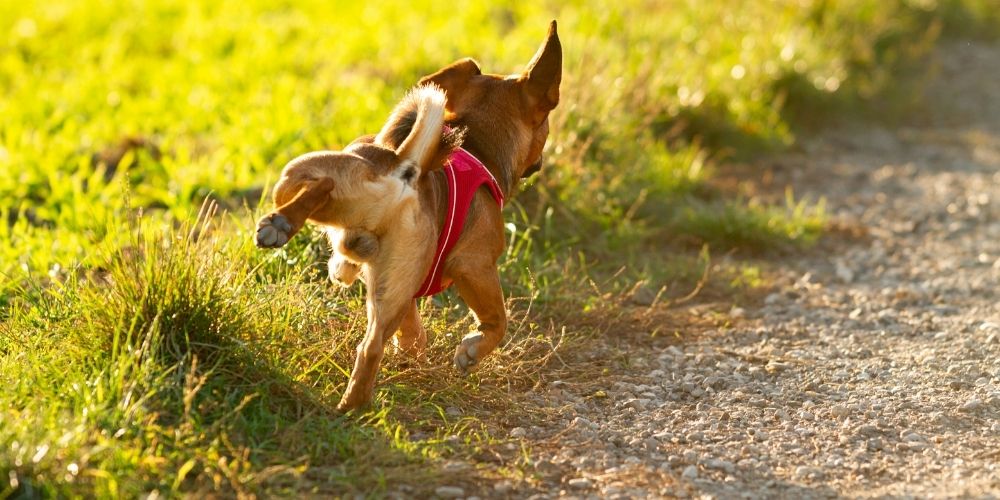There’s nothing worse than a yellow lawn.
Not only does it make your backyard look tacky, but it also devalues your home.
A Property Surveyor looks for lush green grass that attracts attention. It adds a touch of luxury and warmth to your home.
Most of the time, yellow lawns are not too big a problem. With the right care, your backyard will be looking amazing in no time.
And I will show you how in this article.
5 Reasons Your Lawn Is Turning Yellow (And Solutions)
1. Too Much Water
When watering the lawn, some people get carried away. Yes, water is important for grass to grow; however, it’s not the be-all and end-all.
Your lawn also needs sun and nutrients.

Overwatering drowns your lawn, starving your grass of essential oxygen. As a result, yellow patches will start to form.
And if you continue overwatering, these yellow patches will consume your whole lawn.
Not only that but overwatering leads to other issues such as diseases and weed growth.
The Solution
The solution is to only water your lawn when it needs it. Of course, this depends on the climate you’re living in.
In hotter temperatures, you need to water your lawn more. On the flip side, colder climates mean you get away with less watering.
Here’s how to determine whether your lawn needs watering…
Are there footprints left behind when you walk on the grass? If so, your lawn needs to be watered as soon as possible.
Healthy grass springs back into place after you walk on it.
2. Lawn Diseases
A common, but annoying, reason why your lawn may be turning yellow, is because of disease. Lawn disease happens when the grassroots get affected by fungus.
Here are some of the most popular lawn diseases…
Anthracnose
Anthracnose can be broken down into 2 separate diseases:
- Foliar Blight
- Basal Rot
If you’re living in a hotter climate, your lawn is most susceptible to Foliar Blight. With Foliar Blight, your lawn will develop patches with a hay-like color.
On the flip side, Basal Rot is more common in cooler climates. It looks the same as Foliar Blight, with patches of yellow grass.
Brown Patch
When comparing all types of lawn disease, brown patch is the most common. It’s most prevalent in the fall time, when temperatures start to drop.
There are many causes of brown patch.
However, one of the most common is overwatering. When you overwater the lawn, it’s not uncommon for water puddles to form on the grass.
In turn, this drowns the grass and causes brown patches.

With that being said, ‘underwatering’ could also be causing your lawn to turn a brownish-yellow color.
Lack of water in the Summer months is a sure-fire way to kill your grass. Healthy grass can survive a few weeks without water.
But after that…
It goes yellow and dies off.
Dollar Spot
Anthracnose and Brown Patch are more ‘in your face’, as they produce large yellow areas on your lawn.
But Dollar Spot is more subtle.
The yellow spots caused by Dollar Spot are much smaller. About the size of a coin, to be exact. As time goes on, these yellow spots begin to grow if you don’t fix the problem.
In addition, Dollar Spot is most common in hot humid conditions.
So what should you do if you notice Dollar Spot?
I recommend watering intensely, but infrequently, as Dollar spot occurs when the roots need watering, but the grass leaves are moist from humidity.
3. The Wrong Time Of The Year
One of the most common reasons for yellow grass is the time of the year. As the weather gets hotter, it’s normal for grass to dry out.
In turn, this creates a yellow color.
Luckily, there’s a solution.
You can stop your lawn from turning yellow by ensuring it gets enough water. My advice is to install a sprinkler in your backyard.

Sprinklers can run on a schedule, so you never forget to water the lawn again!
Plus, watering the lawn by hand is annoying, stressful, and takes wayyy too long, right!?
In addition, make sure your lawnmower blades are sharp enough. Based on my own experience, dull lawnmower blades pull grass, rather than slice it.
This increases the chances of a yellow lawn.
4. Not Much Fertilization (Or Not Enough!)
Fertilizing your lawn is excellent (and recommended) to ensure your grass flourishes. However, too much, and you may have a problem on your hands.
Excessive fertilizing causes the soil to dry out, resulting in yellow grass that’s unappealing to look at. Not only that, but too much fertilizer can result in some of the lawn diseases mentioned above, which also turn your lawn yellow!

So, how often should you fertilize your lawn?
I recommend it 4 times per year. With that being said, it’s important not to fertilize more than 7 times per year.
What’s more, here’s an excellent tip for choosing the right fertilizer…
Go for something that’s slow-release.
Slow-release makes it difficult to over-fertilize your lawn (providing you stick to 4 times per year!)
Also, slow-release fertilizer ensures your grass doesn’t grow too quickly. Because you don’t want to be mowing the lawn every few days, right!?
5. Lack Of Iron
Something that’s often overlooked when it comes to lawn care is iron. Grass doesn’t need too much iron to be healthy.
However, it needs some.
Before you consider applying iron to your lawn, I recommend getting it tested.
To determine whether your lawn needs iron, you will need a pH test kit. If your pH test results are over 7, there’s a good chance your lawn is not absorbing enough iron.
To prevent this, it’s best to use Sulphur.
If your lawn’s pH levels are too low (below 6), then I recommend using Lawn Lime.
Combine these products with iron, and your backyard will be back to a lush green color in no time!
6. Your Dog’s The Culprit
If you own a puppy, it’s not uncommon for them to do their business on the lawn.
Super annoying, right!?
But did you know it can result in yellow grass?
It’s called ‘Urine Burn’. The reason your grass turns yellow (or brown) is because of the nitrogen in your dog’s urine.

I know what you’re thinking…
“Isn’t nitrogen good for your lawn?”
Yes, but not in large quantities.
If your dog is treating your backyard like a toilet, the large amounts of nitrogen will have adverse effects on your lawn.
To prevent this, there are a few solutions…
My best recommendation is to train your puppy to poop in one specific spot (preferably not on the lawn).
In the meantime, get rid of poop as soon as possible. The longer it sits there, the more it gets absorbed by the lawn.
Common Questions About Yellow Lawns
Can Yellow Grass Become Green Again?
Yes, your grass can become green again.
However, constant lawn care is required. Before you can fix the problem, you need to determine what’s causing the yellow grass in the first place.
Once you’ve found out, you can implement the tips mentioned above.
After a few weeks, you should start to notice a difference. If your grass is yellow because of dehydration, it should be even sooner.
Why Is My Grass Turning Yellow Even After Watering?
It could be for a number of different reasons.
However, from what I’ve seen, it’s from overwatering your lawn. Remember, overwatering can be just as bad as underwatering.
You’re drowning the grass, making it impossible to grow and flourish.
It can also be too much fertilizer, lawn disease, or your lawnmower.
If your lawnmower leaks petrol onto your lawn, you can kiss goodbye to green grass. Therefore, it’s important to check for leaks beforehand.
Can Yellow Lawn Come Back?
Unfortunately, a yellow lawn can come back.
However, it’s 100% in your control. If you look after your lawn by watering, fertilizing, and mowing regularly, it’s unlikely.
Is Yellow Grass Dead Or Dormant?
It’s hard to tell from a visual perspective.
However, here’s how to test whether your grass is dead or dormant…
Pull on the grass leaves and see how difficult they are to remove. If they don’t require any resistance, they’re probably dead.
However, if it requires a substantial amount of effort, they are dormant.
Final Say
Before you start ordering test kits and trying to diagnose your yellow lawn.
Ask yourself…
“Am I overwatering or underwatering the grass?”.
If the answer to this question is no, then you can dig a little deeper. The most likely culprit is lawn disease.
The good news is that it can be cured with the correct lawn care.

